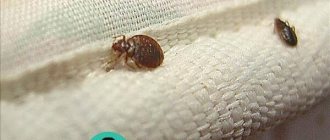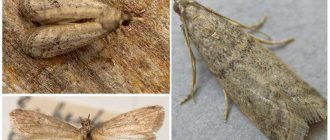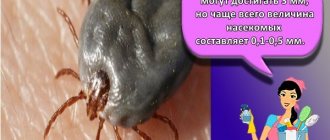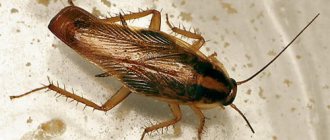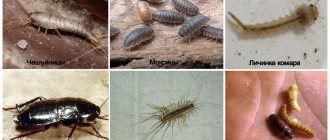What causes moths in an apartment - find out the reasons for their appearance
- Purchasing new furniture that has been in storage for a long time.
- Insufficient care for used furniture (old Soviet sofas, armchairs, mattresses, etc.).
- Moths entered the home with purchased products if they were stored beyond their expiration dates and in unsealed packages.
- Insects are brought into the house as a result of purchasing used clothing from individuals, second-hand stores, etc.
- Moths often enter homes along with donated items.
- Pests easily enter the apartment through ventilation holes and the front door (if the insulation is felt).
- In a multi-storey building, moths can be found when grocery stores and catering establishments are open on the ground floor.
- If there are pets living in the house, they could very well bring insects home. The moth settles in the animal's fur, using it as a temporary shelter.
Before getting rid of moths, it is important to understand that in a house where there are a lot of moths, there is no way it could have come from anywhere. Often homeowners bring in pests with things, equipment, and products that are infested with larvae.
How to understand that there are moths in the house
Study the signs indicating that moths have appeared in your home:
- in places and containers where food is stored, empty cocoons, caterpillars, and winding passages appeared;
- the cereal has stuck together in lumps, losing its crumbly appearance;
- butterflies of a yellowish and grayish color, small in size, fly indoors in the evenings;
- bald spots, yellow maggots and white masonry appeared on the clothes.
Before you quickly get rid of moths and their larvae at home, you need to understand who you have to fight.
What moths are afraid of: repelling methods
One adult moth can lay 150-250 eggs, so it is advisable to prevent its appearance in the house. In addition to purchasing high-quality groceries, installing mosquito nets on windows, and other preventive methods, conditions in the house that are intolerable for the parasite are ensured. Specific smells help with this.
Products from the following categories repel insects:
- dry herbs and spices;
- essential oils;
- live indoor plants;
- fruit particles;
- some technical substances.
Repellents are harmless to humans, their smell does not cause negative sensations in other residents, unlike insect pests.
Spices and plants for moths
Some types of flowers and herbs (green or dried), as well as spices, have an odor that is incompatible with moths being in the house. Due to this property, they are used to repel insects by placing them in places of feeding and possible accumulation. These plant representatives include:
- wormwood (from moths, twigs and leaves are laid out in the closet, among food products, changed every 1-2 weeks);
- lavender (the flowers of the plant have a pleasant aroma for humans, but are intolerant to moths; they are effective for several months without the need to change);
- tansy (flower branches repel moths and other parasites);
- rosemary (we repel moths, but require frequent replacement);
- mint (suitable for protection against clothes moths, has a long-lasting effect);
- dill (in the form of herb or seeds);
- onions and garlic (placed in the kitchen and pantries to prevent food pests);
- red pepper (plant pods are used near cereals, bread products, flour);
- mixtures of chamomile, cloves, valerian, marigold.
Plants without a strong aroma or with a pleasant aroma for humans are placed together with clothes and fabrics. Specific substances are recommended for use in kitchen cabinets.
Twigs, flowers, moth grass are laid out in their natural form or packaged in separate fabric bags. There are special convenient sachets and sections made from natural ingredients on sale.
Essential oil for moths
The listed herbs and plants, some other representatives of the flora are effective against adult moths and their larvae in the form of essential oil. Additional oils used:
- lemon;
- orange;
- lemongrass;
- fir;
- patchouli;
- thyme;
- tea tree.
Extracts are used separately or mixed with each other. The use of essential oils is convenient, they take up less space, and retain their properties for a long time.
For 1 liter of water you need 5-6 drops of the oil composition. The solution is used to wipe the walls of cabinets, dressing rooms, kitchen furniture, and the floor. Pieces of felt, fabric, gauze swabs are dipped into the liquid, and small containers with essential components are placed on the shelves.
Houseplant against moths
Geranium grown at home effectively repels all types of moths. It is recommended to place flowerpots in rooms where food or clothes butterflies can reproduce.
The pest is negatively affected by all parts of the plant. Additionally, individual flower petals or stems are placed under carpets, furniture, between upholstery or clothing.
Another home plant with similar properties is plectranthus (“moth tree”, spur flower). The aromas it produces effectively repel moths.
Fruit peel against moths
The peel of citrus fruits (orange, lemon) is effectively used against moths. It is mainly used against food pests, less often to protect clothing. Parts of the fruit have a pleasant aroma for humans, but require frequent replacement, as they quickly expire.
To protect seasonal natural clothing and winter items, it is recommended to place them in special bags or covers. The peel of an orange or lemon is placed inside the protective devices. Additionally, fabric bags are prepared, which are filled with herbs mixed with citrus peelings.
What moths are afraid of: technical substances and other means
The following items are classified as moth repellents:
- vinegar;
- laundry and some other types of soap;
- synthetic tablets and balls;
- chestnuts;
- ultrasonic repellers.
The latter remedy works only when connected to the network; its use is justified as an additional control measure along with chemical or folk remedies.
A solution of acetic acid is prepared from the product mixed in water (proportion 1:1). The substance is used to prevent the breeding of moths near food. Kitchen furniture is periodically wiped with a cloth soaked in a solution.
Moths do not like the smell of laundry, strawberry, or dust soap. Bars of the product are laid out in places where moths accumulate. An effective method is to periodically wash the floor, furniture and other surfaces in the house with soapy water.
Special anti-moth balls and tablets, common in retail sales, are used to combat moths. Their effect on the larvae is weak. The advantage of the means is compactness and convenience, but compliance with the quantitative measures specified in the instructions is required.
Occasionally, chestnuts are used against moths, the aroma of which is elusive to humans, but unpleasant to insects. Ripe fruits are collected in the fall and laid out among clothes and furniture. It is important to dry the chestnuts because if they are raw they may develop mold.
How to get rid of moths - studying the enemy
The life of a moth is not long, but it is very harmful. In its development it goes through 3 stages:
- Almost invisible eggs, the size of which does not exceed 0.5 mm, are laid by moths on things or products. These items will then be used as food by the emerging larvae.
- Larvae emerge from the eggs. At first they are small, no more than 1 mm, but their appetite is excellent. Therefore, soon the small larvae grow up to 1 cm and even more.
- Then they turn into pupae, from which butterflies fly out. Butterflies lay eggs and the circle closes.
The moth lives 5 weeks. After 3 days, the butterfly can already reproduce. Therefore, it is so important to understand how to get rid of moths and do it quickly, otherwise at home the number of insects will increase uncontrollably.
How to get rid of food and clothes moth larvae - general cleaning
The main danger is larvae. Butterflies are essentially harmless. But they are the ones who give a dangerous signal that the main pests are hiding in secluded places in your home.
How to kill food moth larvae in the kitchen
- Empty the cabinets, collect small particles of cereals with a dry cloth. Go over all surfaces and corners with a vacuum cleaner.
- Soak a sponge in vinegar (table vinegar, apple cider vinegar), squeeze lightly, and treat the inside of the cabinets. Dry with a dry cloth.
- Conduct a thorough inspection of the bags and containers where cereals are stored.
- If, as a result of the inspection, remains of empty cocoons and larvae are revealed, these products should be thrown away immediately; they are contaminated and should not be eaten.
- If there are no clutches of larvae in the cereal, place the dish along with the contents in the microwave for literally 3 minutes (maximum power). If you don't have a microwave, use the oven or freeze the food for at least a week.
- Wash all containers thoroughly in soapy water. Wipe dry, then treat with vinegar.
How to save clothes from clothes moth larvae
- Empty the closet, shake out every item of clothing.
- Throw away old items if they are damaged by moths.
- Dry all your fur clothes on the balcony and dry them in the sun, the ultraviolet will do its job.
- Wash bedding and clothing, especially woolen items. Washing time is at least 45 minutes. Freeze all washed laundry for a day.
- Using furniture cleaner, wash all the walls of the closet where clothes hang and linens are stored.
- Leave moth repellent on each shelf: sections, tablets, traps, etc.
To remove moth larvae from rugs, furniture and carpets, you need to use special sprays and aerosols. Before processing, the rug, carpet or furniture is taken outside and beaten out.
You may be interested: 40 remedies for ants in an apartment or house
Types of moths
- Fur coat . This is a small insect with a maximum wingspan of 15-16 mm, colored clay yellow. There may be small dark spots in front of the central part of the wings. This moth usually eats exclusively clothes made from natural materials. Its larvae are white and look like worms with almost no hairs. They have eight short legs located on the abdomen. The skin is whitish, but almost transparent. Through it you can see the stomach itself and even its contents, the head is brown in color. The larvae usually feed on fur, live in a portable case, and along the way gnaw off all the hair, regardless of whether it will absorb it or not.
- Clothes. It is larger when compared with the fur coat - its wingspan reaches 22-24 mm. The fore wings near the base are violet-brown in color, in the middle area they change color to light yellow, and near the apex there is a violet-brown spot. The head is covered with light fluff. The larva of such a moth is similar to the fur moth. Clothes moth larvae live in the folds or in the depths of cloth or drapery material. Outside, the space that the larvae eat through is almost unnoticeable, however, the outer layer of tissue becomes very, very thin. As a result of this, it breaks through literally in a few days.
- The furniture butterfly is a light yellow butterfly, and its wings are shiny. The head is rusty yellow. Near the base, the fore wings are slightly brownish. The larvae of such moths first eat away the hair stuffing of the furniture. They try to move in the direction of matter patterns. When they are about to pupate, they make their way outside where they congregate on the underside of chairs or sofas. In winter, the development of larvae takes about 5 months, in summer it happens much faster - in just 2 months. Butterflies fly for 3 months - March, April and May, another generation emerges in July and August.
- The cereal is a silvery-white insect. The front wings have a variable brown pattern; the abdomen is gray in color. The span of the hind wings can be 15 mm. Butterflies fly twice a year - in mid-spring and towards the end of the summer. Each female lays up to a hundred eggs on grains of bread, with 1-2 eggs per grain. The larva collects several grains into a common bunch, entwines them with a web and feeds on them. Pupates immediately. Can eat dried fruits and various kinds of seeds.
The most effective means to combat moths and their larvae
When choosing the most effective moth repellent that can be used at home, carefully study the principle of action and the manufacturer’s recommendations.
Products on sale are divided into types:
- traps;
- aerosols;
- tablets (balls);
- sections;
- universal spectrum plates and liquids for fumigators.
The best anti-moth sprays
After the general cleaning is completed, you can begin treating clothes, cabinets and carpets with the chosen product. Aerosol is one of them.
You can buy it at any hardware store. During processing, larvae, eggs and the butterflies themselves are destroyed.
Spray the aerosol directly into the cabinet. Modern drugs have a pleasant smell or no smell at all. Aerosols paralyze the nervous system of insects, which leads to their death.
Aerosol is a very powerful anti-moth remedy. The effect of use is very good. And the wide choice of aerosols makes it possible to buy one that you like, but the moths don’t like.
No. 1. Aerosol “Clean House” Protection against moths
The product smells pleasantly of flowers. The main purpose is to control furniture moths. It cannot be used on fur and textiles. The composition is sprayed evenly over the corners and walls of the furniture. It acts instantly and is used sparingly.
No. 2. Aerosol "Raptor" against moths
The aerosol is produced in a cylinder with a volume of 175 ml. After spraying, the effect lasts for a year. Raptor is harmless to humans and leaves no marks on the treated areas. A fairly effective remedy for moths and larvae in the apartment. The aerosol kills larvae, butterflies and eggs.
No. 3. Aerosol Argus against moths and skin beetles
When sprayed onto wardrobe items, the product leaves a light moisturizing effect. It is also used to treat rugs and shoes. Argus effectively fights moths and skin beetles. Sold in 100 ml cylinders.
No. 4. Aerosol Doctor Klaus Antimol
Lavender scented product Dr. Klaus helps to get rid of moths and their larvae at home very quickly. Available in a volume of 300 ml, it is consumed sparingly. The aerosol is effective against clothes moths. It is used to treat dressing rooms containing woolen products.
No. 5. Aerosol Armol Expert
The aerosol has a pleasant lavender scent. If you don't like the scent, you can buy unscented Armol. They destroy pests that live on textiles, furniture, carpets and clothes. There are no stains left after treatment.
No. 6. Mosquitoll Moth protection
One bottle can treat a surface of up to 8 square meters. m. The product does not harm humans and effectively eliminates larvae in wool, silk and fur products. Mosquitoll does not contain harmful substances and smells pleasant of lavender. The result lasts throughout the year.
How to use moth sprays
- Open the windows.
- Hide toys and other things in a drawer.
- Spray the closet or other place where the moth was found.
After the room has been treated, you need to leave it for a couple of hours. Usually this time is enough to completely destroy the enemy.
Remember safety precautions when processing:
- If you have a respirator at home, use it.
- All household members, especially children and animals, should also be isolated.
Fighting methods
How to destroy moths in an apartment? For this purpose, you can use the following methods and means:
- heat treatment;
- chemicals;
- folk remedies.
Let's look at each of them in more detail.
Heat treatment
As is known, these insects are able to exist in a certain temperature range, which is -5°C ... +45°C. And if the thermometer scale crosses one of these, the moth is guaranteed to die. What can be done?
- If parasites have settled in your apartment during the cold season, then you can simply open the windows and freeze out all the pests in just a few hours. In this case, both adult butterflies and larvae are guaranteed to die.
Important! Don't forget that low temperatures can not only kill moths, but also damage the heating system! Therefore, the batteries must be protected first!
- Another method is to wash contaminated items at the maximum permissible temperature in automatic mode. But it is clear that this method is only suitable for clothing; furniture and carpets should be processed using industrial units.
- If moths have infested fur products, there are special refrigeration chambers for them.
On a note! It is useless to destroy only flying butterflies mechanically, that is, using a rolled-up newspaper or a slipper, since the main pest will remain in the clothes and continue to spoil them!
Chemicals
The best results in the fight against body parasites come from using insecticidal preparations specially created for this purpose. They are available in several types: aerosols, fumigators and repellent sections.
Aerosol
Anti-moth aerosol is the most convenient chemical preparation that is quite effective. With its help you can destroy both butterflies and small larvae. Each aerosol is based on a powerful toxic substance, but does not leave behind any unpleasant odor. Moreover, most of these products contain aromatic fragrances.
Using aerosol insecticides is very simple: spray the product on clothing, the inside of cabinets, carpets and upholstery. Modern preparations can rid your home of parasites in a short period of time and at the same time will be completely safe for fabrics - they will not leave any stains or unpleasant odors.
Important! It should be remembered that an aerosol cloud consists of tiny particles that can quickly and easily penetrate the respiratory tract. A high concentration of toxic substances often causes severe poisoning. Therefore, before using this or that anti-moth aerosol, you should carefully study the instructions and do not forget about personal protective equipment!
Among the aerosols against moths, the most popular are: “Moskitol”, “Armol”, “Antimol”, “Dezmol”, “Foxide”.
Fumigators
Fumigators are also quite effective in combating moths. There are two types of fumigators on sale: electric and pyrotechnic. The principle of their operation is largely similar - the first begin to emit toxic substances after the electrical plates are heated, the second emit toxic smoke after the spiral is set on fire.
The most popular moth fumigators today are: “Moskitol”, “Raid” and “Raptor”. In fact, they are designed to kill mosquitoes, but, as the manufacturer assures and practice shows, they are quite effective against moths. These devices are safe for human and pet health and do not leave any odor after use.
On a note! You can find two types of electric fumigators on sale: the first ones work on plates that need to be changed every time they are turned on, the second ones have a reservoir with liquid and this device lasts for a longer period!
Sections
Sections are the most primitive and at the same time simplest way to get rid of moths. These devices are small plates impregnated with a special substance that repels pests. The sections should simply be hung in a closed cabinet or placed on shelves. After some time the moth will disappear.
On sale today you can find a huge number of sections against moths. They have different shapes and aroma, which allows the consumer to choose a model to suit their taste. The sections “Raid”, “Raptor”, “Antimol”, “Gardex” and “Moskitol” are popular today.
Effective traps for moth control
Traps are safe remedies for moths in the apartment, which help to quickly achieve the desired result. They are placed in closets and places where moths have been spotted.
The most popular moth traps:
- Aeroxon - 2 replacement pencil cases, 450 rub.
- Swissinno - 2 replacement pencil cases, 800 rub.
- Argus - 6 replacement pencil cases, 180 rub.
Design and principle of operation of traps
- The trap looks like a flat box with holes on all sides. This is where the moths crawl.
- Glue is applied inside the trap. Thanks to its special composition, it does not dry out and does not allow butterflies to fly away. They die.
- Traps are completely harmless to humans and animals. Experts advise placing them on cabinet shelves, bedside tables, etc.
The best fumigators for moths
Many people believe that fumigators can only fight mosquitoes. But that's not true. Fumigators are also great against moths.
Using them is quite simple - you just need to stretch the extension cord into the closet and plug the fumigator into an outlet.
No. 1. Raid
The fumigator can be used both with plates and with a special container for liquid. It effectively destroys moths in a short time.
No. 2. Mosquitoll
It is enough to connect the device to the network to start the process of evaporation of the liquid. It is popular among consumers due to its high performance.
No. 2. Raptor
The principle of operation of the fumigator is the same as all the others. There is no smell coming from it. It works with liquid and plates, depending on the type of device.
The disadvantage of this method is that it takes a long time, since getting rid of moths using fumigators at home is not always easy. The process may take weeks.
The instructions say that the fumigator can be left plugged in both day and night. Nothing bad will happen during this period. The fumigator is safe for people and pets.
Types and main habitats of moths
Moths belong to the order of butterflies. The size and appearance of the insect depend on the species. House moths in everyday life are usually called:
- fur coat,
- grain (bread),
- wardrobe (room),
- carpet,
- some other types.
Adults are not very large and can reach fifteen millimeters. Butterflies are usually painted in dirty colors, often gray-green or gray-brown. Moths are found not only indoors, but also in nature. Species living on fruit trees and vegetables are widespread.
Effective tablets (balls) against moths
Of course, we are not talking about those pills that housewives take to calm down when they see a moth. We are talking about means to help fight this scourge. The tablet is a compact and reliable solution that allows you to protect products made from fur, felt, wool, and textiles.
Anti-moth tablets (balls) are placed in a drawer or closet, protecting your clothes from pests. Modern products are endowed with a pleasant aroma of lavender; it is often included in the composition. This is how tablets and balls differ from old mothballs, which permeated clothes with a characteristic and very specific smell.
No. 1. Clean House Antimol Extra
Scented balls are designed to protect wool and fur from moths and skin beetles. They are placed on shelves and in cabinet drawers. The duration of impact is a full six months, reviews confirm the effectiveness of the balls within the specified period.
No. 2. Greenfield Antimol Effect
The tablets are made from talc with a lavender scent. They are effective for 6 months. Sold in packages weighing 100 g. This volume is enough to fit in a large closet. It is important to use the tablets correctly (read the instructions). Otherwise, they can have a depressing effect on the respiratory system and liver.
The tablets provide effect for up to six months. When using them, it is important to avoid contact with skin and mucous membranes. Safety precautions must be taken to prevent children from getting to the balls.
Effective and safe sections against moths
The sections prevent the appearance of moths and destroy them. But they do not affect the larvae.
The best anti-moth sections:
- Mosquitoll - reliable protection and elimination of moths in the house and country house, validity period - 6 months;
- Armol - helps fight moths and deodorizes clothing, ideal protection for items made of fur, leather, wool, textiles;
- Raptor is an improved formula with a pleasant lavender scent.
It is recommended to purchase sections in addition to the use of other products or after the complete removal of moth larvae.
Reasons for the appearance and spread of moths
You can bring moths into your home in different ways. It can fly in through an open window, but the following are considered the main reasons for its appearance:
- Products. If basic rules for storing goods were not followed in a store or production facility, then it is quite possible for moth larvae to appear there. The same applies to goods with broken sealed packaging. Foods favored by insects include dried fruits, mushrooms, spices, nuts, cereals, cookies, and flour.
- New things or interior items. The most “dangerous” are knitted and woolen products, fur coats, fur shoes, furniture, and various carpets.
- Items or furniture purchased in stores or secondhand are possible carriers of larvae. After purchase, they require mandatory treatment against moths.
- Animals. Typically, pets with long hair become carriers of insect pests.
- Ventilation. Ventilation shafts are a kind of route for the movement of adult butterflies to a new territory.
- Books. The copies stored in the library will become an excellent breeding ground for bugs.
An interesting fact about the appearance of moths in an apartment is that the insect lives and produces offspring regardless of the cleanliness of the room. The presence of food is the only condition for the life of a pest butterfly.
How to get rid of moths in the house forever - 7 folk remedies
To say goodbye to pests, you need to prepare a special folk remedy with your own hands.
No. 1. Lavender oil
Lavender oil is a well-known pest control agent. Soak the sponges in it and place them on the shelves. Every 2 weeks, cotton pads are replaced with new ones.
No. 2. Sagebrush
Since you can quickly get rid of moths that you find at home using wormwood, do not miss this opportunity. The smell of the plant will repel pests. Dried wormwood is laid out in fabric bags and then placed in different corners of the cabinet.
No. 3. Dried or fresh citrus zest
To place citrus zest, you should take gauze bags and place dried fruit peels there. You can take any citrus fruits you like.
No. 4. Dried lavender
Lavender is an affordable and safe remedy for moths in the apartment (folk). Make small bags of thin fabric and place the herbs inside. Put it in your pockets, hang it in your closets, leave it in your drawers.
No. 5. Carnation buds
To combat moths, dried clove buds that have not had time to open are used. They have a tart aroma and quickly eliminate the problem. You need to take fabric bags, place the buds inside, put them on shelves or hang them in the closet.
No. 6. Geranium
Geranium is an effective home remedy for moths, which often live in the closet with clothes. Collect the plants in advance and then leave them to dry. Pack the herb preparations into small linen bags. They should be placed on shelves, in pockets of things, drawers with linen.
No. 7. Frost and sun
Insects cannot survive in extremely low or high temperatures. Therefore, with the arrival of summer, all clothes need to be taken out into the sun and left for at least 5 hours. With the arrival of winter, the same must be done in the cold.
We recommend reading: 20 most effective remedies for cockroaches
What plants will help fight moths
Plants with a rich aroma are a good method of controlling house moths. Their action is effective, but absolutely safe for children, animals and food.
Caucasian chamomile
Caucasian chamomile.
To protect your room from moths using Caucasian chamomile, you need to buy powder from crushed inflorescences. They contain a large amount of permethrin, a substance that is a strong natural insecticide.
To quickly and painlessly eliminate moths, you need to sprinkle this powder little by little around the room.
Fragrant tobacco
This pretty plant has a special aroma that moths don’t like at all. If this flower grows and blooms on a windowsill in an apartment or house, then moths will not get into the house.
Some people collect the leaves of the flower, dry them and put them in closets or even in clothing pockets. But in this case, you need to be prepared that things will also acquire a persistent aroma.
Fragrant tobacco.
Lavender and mint
The fragrant perennial plant will also easily protect any room from pest invasion.
You just need to cut a few branches along with the inflorescences, dry them and place them in a fabric or paper bag.
This natural fragrance can be placed on a shelf in a closet with food or clothing.
Mint is used in the same way as previous herbal plants. Dried leaves are placed in bags, and then they are laid out around the entire perimeter of the room that you want to protect. It will be necessary to check their condition and aroma periodically. When the bag is exhausted, and this happens after approximately 2 months, you just need to replace it with a new one.
Geranium
The essential oil, which is found in the leaves and flowers of geranium, effectively protects any premises from house moths. If geranium grows and blooms on the windowsill, then you don’t have to worry about pests getting into the room. For prevention during flowering, it is necessary to periodically open the cabinet doors to ventilate them.
Indoor geranium is a natural antiseptic.
Scented herbs
Bouquet of herbs against moths.
Some herbs frankly dislike moths. Among them are wormwood, oregano, tansy, valerian or bay leaf.
To produce the desired effect, you need to cut the branches, dry them and place them in gauze bags. These bundles are placed on closet shelves to remove pests. The ideal option would be a combination of several types of herbs. The effect lasts up to 3 months.
How to get rid of food moths in the kitchen quickly and forever
If the rooms of the apartment are the kingdom of the clothes moth, then the kitchen belongs entirely to its close relative - the food moth. This moth is also called grain moth, as it has a weakness for cereals. But besides cereals, she loves flour and flour products, as well as dried fruits.
If you want to check whether there are food moths in your kitchen, or whether you managed to get rid of them after using the methods described below, do not be lazy to get up at night and turn on the light in the kitchen. Adults will gather near a burning chandelier.
Grain moth reproduces well in places with high humidity and lack of drafts. By the way, moths are very afraid of cold weather.
Having climbed into a container with cereal, the moth lays eggs. After a certain time, the larvae hatch and grow rapidly, eating food in large quantities.
The larvae gradually turn into caterpillars, which further harm the product and completely spoil it. They entwine the grains with a sticky web, as a result of which the grains stick together into clumps. It is highly undesirable to eat such grains. All that remains is to throw it away.
Furniture moth and clothes moth: what is the difference?
Clothes moths and furniture moths will have their own separate diets - the first feeds on cotton products, the second on fur and wool. In nature, this is what happens, but in an apartment, each of these species can quite easily move from one food to another. Therefore, today these butterflies are collectively called clothes moths.
In fact, these insects have many similar characteristics:
- the body is small in size and length is no more than 9 mm;
- the color is straw-yellow, rather inconspicuous, especially with folded wings;
- Only males can fly, but representatives of both the first and second species do it rather ineptly;
- females of both species do not use wings, although they have the ability to fly; their wings are somewhat smaller in size compared to the wings of males.
Distinctive features can only be noticed upon closer examination - the furniture moth will have a darker color and dark areas at the base of the wings.
Moth larvae as the main pest
However, the greatest damage is caused not by winged insects, but by their larvae. It is the small caterpillars that parasitize in your sweaters, expensive fur coats and carpets; they are the ones who leave behind holes in clothes and furniture upholstery; they are the real household pests.
The growth and development of house moth larvae directly depends on diet and temperature conditions:
- if the food they absorb consists only of natural materials, then the development of the caterpillars will occur quite quickly - in 3 weeks they will have time to molt about 12 times and pupate;
- if the food is rich in synthetic fibers, which are very poorly digested, accordingly, the growth of the larvae will slow down somewhat - this period will take 2 months or even six months;
- As for temperature conditions, when the ambient temperature drops significantly, the rate of growth and development of young animals noticeably decreases, the caterpillars become smaller, and at especially low temperatures they weave cocoons around their body, stop feeding and freeze.
But if your apartment is cozy, warm and there is something to profit from, in particular, products made from natural materials, then moth caterpillars will feel great there. With their mandibles, which is the name of their oral apparatus, presented in the form of two large outgrowths, they deftly trim fabric fibers and wool. Thanks to powerful jaw muscles, the larvae quickly gnaw fairly large areas of matter and direct food into the stomach, from where it enters the intestines.
On a note! Compared to the body, the stomach and intestines of the larvae are enormous in size and can hold quite a large amount of food!
The larvae of clothes moths and furniture moths are somewhat different from each other.
Absolutely all larvae lead a sedentary lifestyle and do not crawl far from the place where they emerge from the egg. Until they turn into a butterfly, they spend almost all their time in one place. But as soon as the larva becomes an adult, it stops feeding and spends the rest of its life, which lasts only a few days, only on reproduction.
How to get rid of moths and their larvae in the kitchen in cereals
- Inspect the products. If damaged by moths, throw them away immediately.
- If you do not want to get rid of food, carefully sort the grains and bake in the oven for 30 minutes. There is no need to set a very high temperature during calcination; 60 degrees is enough. The oven door needs to be opened slightly.
- You can put the cereal in the microwave for a couple of minutes. But still, the best option in such a situation would be to throw away the food and immediately take out the trash can.
- There is the opposite option - put the contaminated cereal in the freezer. Sub-zero temperatures can completely kill pests. The more frosty it is in your refrigerator, the better the result.
- After processing, store cereals and other products in containers that are tightly closed. Periodically conduct a full inspection of products that are at risk.
How to quickly remove moths from kitchen cabinets
- The kitchen cabinet in which contaminated food was stored should be thoroughly vacuumed, washed, and then treated with vinegar.
- It is important to reach every nook and cranny and treat it. Otherwise the result will be in vain.
- Don't ignore the areas next to the cabinets in the kitchen. Inspect the ceiling, ceiling skirting boards, edges of wallpaper and even the base of the chandelier. Moth cocoons can be everywhere.
Effective folk remedies in the fight against food moths
Food moths quickly infect food, since not everyone succeeds in getting rid of it at home the first time. Here are folk remedies that need to be used after general cleaning of closets.
No. 1. Garlic
Place the garlic cloves along with the cereal in one container to prevent moth larvae from appearing.
No. 2. Bay leaf
The pungent odor of the plant has a detrimental effect on moths, which allows you to get rid of them.
No. 3. Tobacco
To prevent pests or remove them from cabinets, place tobacco products on the shelves.
No. 4. Table vinegar
You can both get rid of food moths and prevent their appearance in your apartment using vinegar. It is enough to vacuum the cabinets, wipe with vinegar and ventilate.
No. 5. Lavender or citrus zest
Place dried citrus zest or lavender on all surfaces on which containers or bags of cereal are placed.
Prevention measures
To prevent pests from appearing in your home or area, you need to take simple preventive measures. Knowing what attracts him, you can prevent its occurrence. The following rules apply in the apartment:
- Keep the room clean. Clean the rooms and kitchen in a timely manner and regularly ventilate the premises.
- Do not buy expired or low-quality cereals, flour and dried fruits. They can become a breeding ground for parasites. After purchasing cereal, it is advisable to carefully inspect it for the presence of various worms.
- Use airtight containers to store food. Adults can crawl into the smallest cracks, so containers for storing cereals, nuts or dried fruits must be airtight.
- Do not buy food for future use. Huge bags of cereals and flour are a real haven for the larvae, so in order not to throw away contaminated food, buy as much of it as you will eat in the near future.
- Follow the storage rules. Fur and leather products should be stored in special cases, fur hats or woolen hats should be stored in boxes, and the insoles should be removed from shoes. Put away clean clothes and shoes for storage - parasites are attracted to the smell of sweat and particles of human skin.
- Air and beat carpets, pillows, blankets and mattresses regularly. Insects, as we remember, cannot tolerate drafts, so you need to periodically ventilate those interior and household items that the larvae usually choose to live in.
- Wipe shelves and cabinets in the kitchen with a vinegar solution.
As you can see, fighting moths is quite possible with the help of home remedies. The key point is that when you detect the first signs of a pest, do not waste time and immediately begin to destroy it. But please note that if the moment is missed and there are too many insects, the use of chemicals is necessary.
Prevention of moths and their larvae
After removing clothes or food moths, take preventive measures:
- inspect existing products, furniture and belongings to detect larvae in time;
- place all cereals in sealable containers;
- Wipe the doors and shelves of cabinets in the kitchen and rooms with soapy water (moths hate laundry soap);
- pack woolen items in thick bags, after drying them in the sun;
- systematically ventilate clothes, shoes, and fur coats;
- place fur products in special storage cases;
- do not put back into the closet things you recently wore outside;
- get rid of unnecessary things by throwing away old clothes, furniture, soft toys, pillows and everything that has not been used for a long time;
- periodically inspect bed linen, beat carpets and rugs on the street;
- place moth tablets or plates, dried herbs (lavender, mint, cloves) on the shelves, so the moth will not take root and will not lay eggs.

